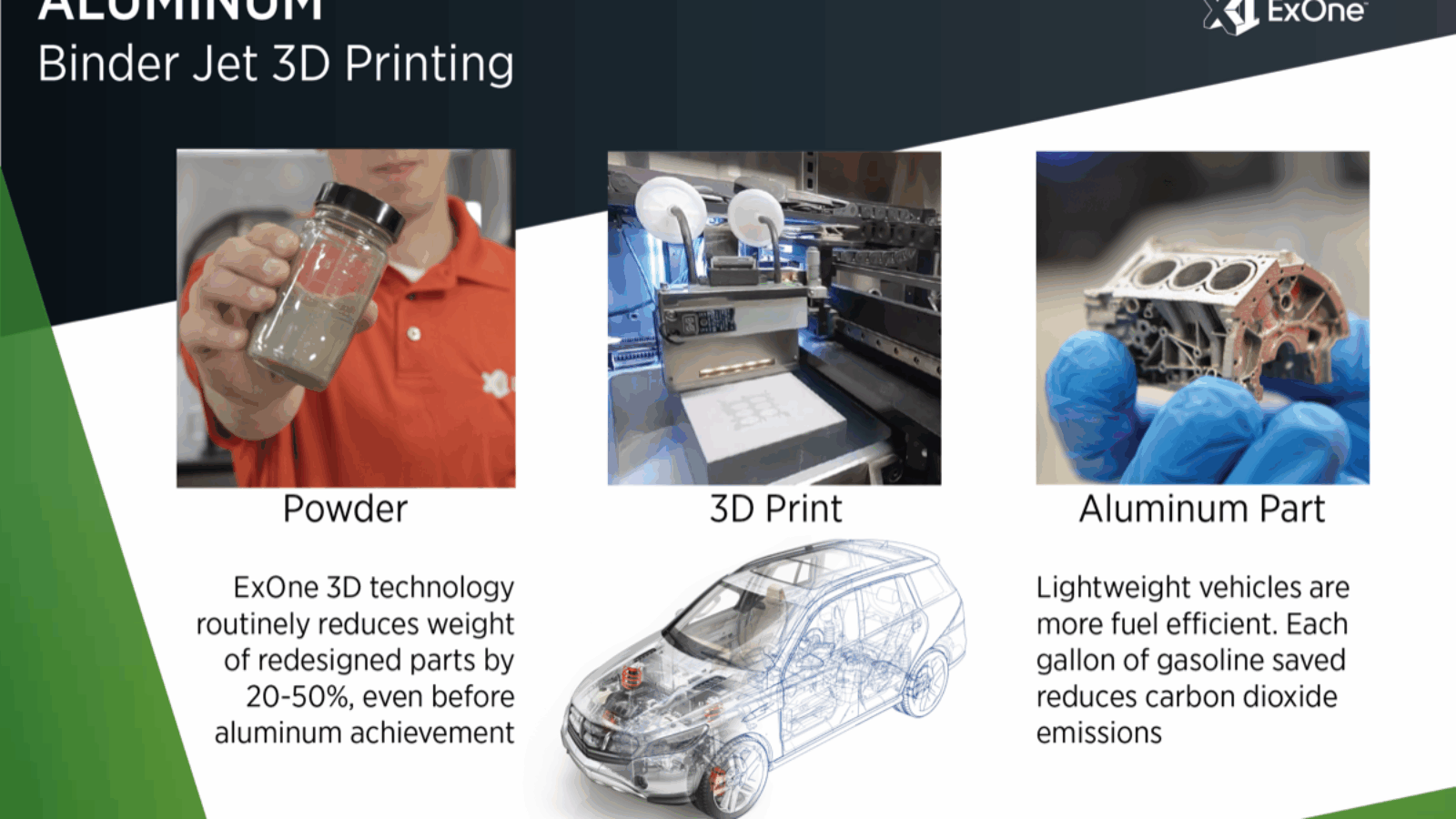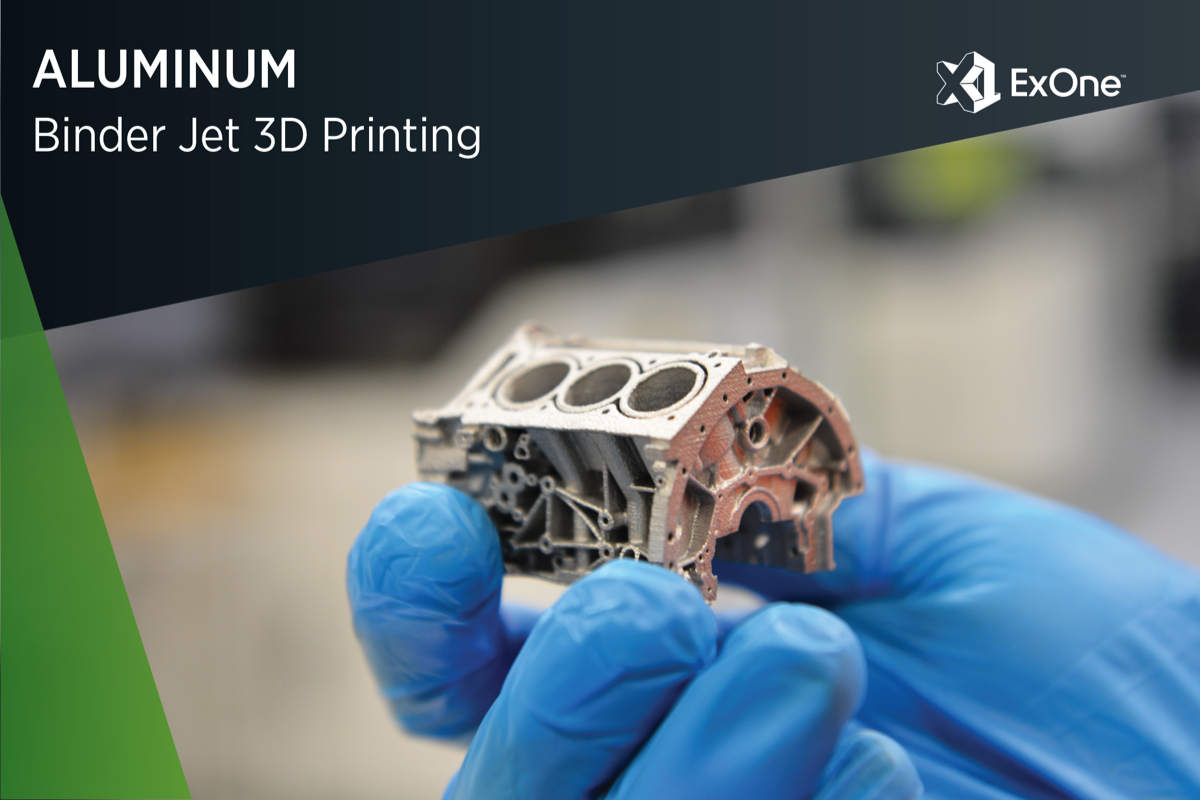The hottest competition is in metal binder jetting and so it happens that, on the same day, two leaders in this field make a comparable breakthrough announcement: the ability to 3D print aluminum 6061 alloy by binder jetting and, more importantly, to proficiently sinter it. ExOne achieved this aluminum binder jetting breakthrough by working with Ford Motors Company on a new patent-pending process.
Aluminum 6061 is one of the most commonly used aluminum alloys in the world. It has many general purpose applications and is commonly used in aerospace and automotive for large-scale production applications that are considered an ideal target for metal binder jetting production processes, however, it could not be easily and proficiently sintered. However, it only took a couple of years of serious development on metal binder jetting industrialization to achieve this goal.
We sometimes wonder why additive manufacturing is so much more exciting than all other manufacturing processes—even highly automated ones—so much so that many professionals and media involved in this field feel a true passion for it. Almost like gaming or digital entertainment. It’s because, although sometimes it doesn’t seem like it from the outside, innovation goes at breakneck speed in AM and the technology grows at Moore’s Law-like rates.
The new patent-pending process developed by ExOne and Ford Motor Co. for binder jetting 6061 aluminum can deliver final parts with 99% density. In the project, which was co-founded by Ford and ExOne, a team of engineers, material scientists, and manufacturing experts developed a process for rapid and reliable binder jet 3D printing and sintering of aluminum that delivers properties comparable to die casting.
Delivering a commercially viable achievement in this area has evaded researchers for more than a decade. Collaborative and individual patents are expected to be filed by Ford and ExOne as a result of this ongoing project.
Manufacturing on Demand
Some aluminum alloys can be 3D printed today using lasers, but the process is much slower than the one developed by Ford and ExOne. The new process is expected to increase Ford’s efficiency by allowing the company to affordably produce complex parts uniquely designed for additive manufacturing, which enables size and weight reductions, part consolidation, and performance improvements.
“This is a breakthrough in making 3D printed and sintered parts for the auto industry,” said Harold Sears, Ford technical leader for additive manufacturing. “While the 3D-printing process is very different than stamping body panels, we understand the behavior of aluminum better today, as well as its value in light-weighting vehicles. High-speed aluminum 3D printing paves the way for other opportunities that we’re just now starting to take a look at because of the ability to do complex parts with aluminum that previously weren’t possible. It’s really opening doors for other opportunities.”
“Developing a fast, affordable, and easy way to 3D print aluminum with traditional material properties is a critical step toward light-weighting more products and delivering a more sustainable future,” said John Hartner, ExOne CEO. “Our world-class engineers and scientists are focused on solving the toughest problems with 3D printing technology, and this achievement is a real win for all of us.”
The new innovation came about through the process of binder jetting, widely regarded as the fastest method of metal 3D printing for high-volume output. It uses a digital file to quickly inkjet a binder into a bed of powder particles such as metal, sand, or ceramic to create a solid part, one thin layer at a time. When printing metals, the final bound metal part must be sintered in a furnace to fuse the particles together into a solid object. The heating process reinforces the strength and integrity of the metal, and while the process for sintering stainless steel is well understood, achieving high densities greater than 99 percent is an industry breakthrough for aluminum.
The Ford-ExOne joint development project was first initiated in 2019. Ford has led the final material and repeatability testing to verify its accuracy. The cross-functional Ford-ExOne team is actively working on designs to use the new material and process.
The relationship between Ford and ExOne goes back to the early 2000s when Ford purchased several of ExOne’s first industrial sand 3D printers in the United States to create sand molds and cores for metal casting. ExOne 3D printers are among a wide range of technologies featured in Ford’s Advanced Manufacturing Center in Redford, Mich., with additional ExOne printers in Ford’s UK facilities.
* This article is reprinted from 3D Printing Media Network. If you are involved in infringement, please contact us to delete it.
Author: Davide Sher




Leave A Comment